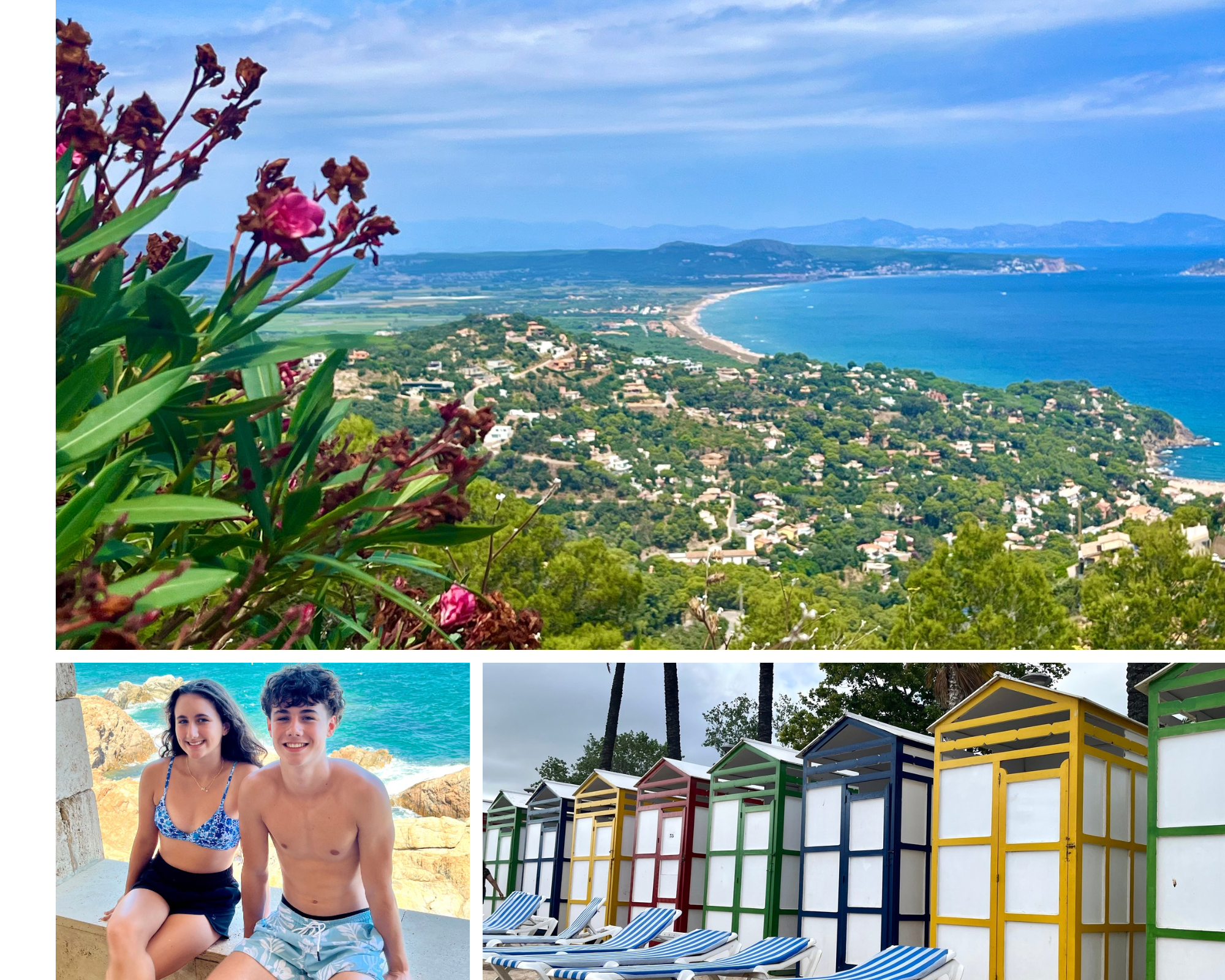Visiting Spain? 17 Know-Before-You Go Tips for Your First Trip
First-time trip to Spain? Here are 17 tips and tricks we wish we knew before our own intro to this fantastic European country.
Let us help plan your dream vacation! Message us HERE to learn more! ~
Let us help plan your dream vacation! Message us HERE to learn more! ~
Spain is a travel-worthy family vacation destination for so many reasons. From delicious food to cultural sites, there’s lots to do in this beautiful European country.
So there’s no wonder Spain recently ranked as the second most popular destination globally (after France).
This tapa-eating and flamenco-dancing locale has a few secrets up its sleeve for those who’ve never been there though.
But, never fear fellow travel warriors. We’ve got tips and tricks for your first visit to Spain that will have you traveling like a pro.
The Serpentine Bench in Park Guell features intricate mosaics designed by Antonio Gaudi and Josep Maria Jujol.
You May want some euros in cash.
I know, I know - card is king these days. And, yes, you can pay for pretty much everything with a credit card in Spain.
But, we quickly found ourselves wishing we would have converted some dollars to Euros for our trip. Having a little cash to hand to people providing a service would have been great.
Also, some businesses charge a small fee for credit card purchases. Or they may have a minimum purchase amount. Plus, some times a little cash just seems quicker and easier for little necessities.
2. Tipping is not as common as in the U.S., but rounding up 5-10% is appreciated.
Anyone else get a little confused when you Google “tipping in Spain”?
After being there, I think we may have figured it out.
While tipping 18-20% in the United States is normal, tipping in Spain is not as expected at that rate. However, we definitely felt those providing a service - like driving, helping with bags, or serving a drink - expected something. This was especially true in nice hotels. And perhaps especially expected from Americans, from whom tipping is customary.
This is great reason to bring some Euros too.
3. Don’t forget to pack electric converters.
After a long flight, realizing you have no way to charge your phone can start things off on the wrong foot. If you’ve been to Europe before, you probably know you’ll need electric converters. Plugging in phone chargers or anything else requiring electricity means you’ll need a special device.
Make sure you‘re bringing the correct converter though. The United Kingdom and Spain do not use the same type of electrical plugs. Spain primarily uses type C and type F plugs, which has two round metal pins.
4. Hotels will require your passport when you check in.
Already cleared customs? Don’t put those passports away quite yet. All the hotels we checked into in Spain required our passports. This is common practice when traveling to many countries and Spain is no exception.
5. Trying a few words of Spanish is APPRECIATED .
Tools like Google Translate go a long way in making conversation easier when traveling abroad.
But, it’s always polite to know a few words of Spanish. It shows you recognize you’re a guest in someone else’s country. Simple words like “hello”, “good morning”, and “thank-you” sets the stage for being a welcomed tourist.
You might not need all the phrases on this list of Spanish phrases for traveling. But, knowing a few is a great idea.
Clockwise from top left: Park Guell, La Sagrada Familia, Pueblo Español, and Montserrat
6. You’ll hear English often.
While trying your best speaking Spanish in Spain is a good idea, don’t stress of you’re not bilingual.
It’s pretty easy to get around Spain without speaking fluent Spanish, especially in larger cities or towns. Even in smaller areas, we found many people speak English. Those who didn’t, were patient with polite tourists.
We were interested to find that we often heard people from non-English speaking countries conversing with Spaniards in English. For example, we heard Spaniards who didn’t speak French talking to people from France in English. Travel is learning after all, so we’re always fascinated to learn how things work in other places.
7. Uber is not common.
Ride apps like Uber and Lyft are commonplace in the U.S., with even my small town having some drivers. But, they’re not used as often in Spain. You’re more likely to find drivers using Cabify.
Taxis are also available and the staff front desk of hotels can help guests secure one if needed. But make sure to allow a little time for one to show up.
Renting a car is advantageous in some smaller areas as well. We were glad we rented a vehicle when we visited Costa Brava for example.
Bus and train services are other great ways to get around Spain, although not available everywhere.
A little research about transportation options in the specific area you’ll be visiting can go a long way.
8. In-country flights are offered at low prices.
Trains, buses, and cars can get you around much of Spain. But as the fourth largest country in Europe, a lot of the country is best reached by plane.
A quick Google Flights search will show you that flying from one Spanish town to the next is often cheaper than in the U.S. The same is true for flying from some Spanish cities to other European cities.
You won’t likely find the best deal, or any flight for that matter, on airlines you use in the states. Rather, companies like Ryanair, Air Europa, and Vueling will be your go-to’s.
9. People dress up A bit more than in many places in the states.
Knowing what to pack and how to dress is the first step to a great vacation.
Like some other Europeans, Spaniards, especially women, tend to dress more classic than vacationers in some parts of the U.S.
For example, we saw few of the cropped tops and cut-off jean shorts that are popular where we live. Rather, women wore casual dresses, skirts, dressier shirts and flowy pants for warm weather. While still not overly dressy, outfits we saw were a little more conservative.
There are few dress restrictions so you don’t need to dress out of your comfort zone. But, if you want to look a little less like a tourist, opt for a more put together look.
10. Appropriate dress is important for some popular places.
Some of the best tourist attractions in Spain are places of worship. For example, La Sagrada Familia in Barcelona is a basilica and Montserrat, outside of the city, is a monastery.
We found dress codes to be a little difficult to determine for these places. But, a good rule of thumb is to simply dress respectfully. Don’t wear anything too revealing, like short shorts. A shaw for women is a good idea to play it safe. Hats are off limits and clothes with logos, like for sports teams, are discouraged.
Gaudi’s architectural designs are visited by millions every year.
11. Siesta time is often observed, especially OUTSIDE of the LARGEST cities.
That long standing tradition of resting during the afternoon, the hottest part of the day, is still often observed in Spain.
You’re won’t find as many places closed for siesta in big cities. Although some smaller business still shutter for a few hours even in metropolitan areas.
But outside of large cities, it’s a common practice. In our hotel, even recreation services, like the tennis courts, were closed from 1-4:00. One food service areas stayed open for guests on property, although most restaurants closed after 1:00 or 2:00.
The exact time that restaurants, shops, and services close varies.
12. Spaniards eat dinner late.
Can you tell yet what one of our favorite things to do is while traveling? We love to eat our way through any place we visit.
In Spain, most places don’t even open for dinner until 8:00, giving “early bird specials” a whole new meaning.
So plan accordingly for filling bellies later than you might at home.
13. You need to ask for your check at the end of the meal at a restaurant.
Meals in Spain are meant for long conversations and, of course, great food. The unhurried pace is ideal for enjoying time with others while sampling their famous cuisine.
We found that it often took longer for a server to come to the table to get our order. And the check for the meal never came until we specifically asked for it.
Interestingly, once we placed our orders, food usually came quicker than it does in the states. With many restaurants specializing in the things they do well as opposed to extensive menu options, preparation is streamlined.
14. Smoking is allowed in outdoor restaurant areas.
Smoking inside in restaurants has been banned in Spain. But, don’t be surprised to see smokers lighting up in outdoor dining spaces.
Even in upscale restaurants, smoking at the table while seated outside is common.
Likewise, our outdoor patios in hotels were equipped with ashtrays, something not generally found in the U.S.
15. Your favorite adult beverage may translate differently than you would guess.
Remember how your high school foreign language teacher said not everything translates verbatim? He or she probably didn’t have adult drinks in mind with that little lesson. However, we’ve got you covered.
Red wine, for example, is not directly translated. Red wine is translated as “tinted wine” or “vino tinto”.
And beer? While Spaniards will know what you mean when you say “cerveza”, “caña” is more common.
The Costa Brava region is just one of Spain’s famous beach areas.
16. Food portions are often smaller.
If you’re a mom of teen boys, you’ll understand why this tip deserves a spot on the list.
Food portions have gotten large in the U.S., but not necessarily in other countries.
We often found dishes to be a little smaller than what we might order at home. If you have a hangry teen, do as the Spanish do. Order tapas while you wait on your entree to stave off big appetites.
17. Some women go topless on the beaches.
Take it from the mom who forgot to mention this to her kids before our family vacation to Spain. Letting your kids know about this cultural difference might be a good idea.
While most women are not topless on the beaches of Spain, a fairly small percentage choose bottoms only while sunbathing. On a crowded day during peak season at the beach, you’re very likely to spot a few ladies sans tops. While this practice is common in beaches, you generally do not see topless sunbathers at pools.
What tips and tricks do you have for visiting Spain for the first time? We want to hear them in the comments below.







